Introduction
Let’s face it; Salesforce is likely one of the most expensive tools in your tech stack. Even if you ignore the $25-$300 per month/per user charge, you’re dishing out administrative fees, consulting fees, integration fees, and more that stack up to hundreds of thousands of dollars.
In fact, according to a 2021 IDC Report , for every $1 spent on Salesforce, $6.19 will be spent in the Salesforce partner ecosystem by 2026.
With such a massive investment, it’s essential to ensure that employees leverage and gain value from the platform. Yet, less than 40% of CRM customers have end-user adoption rates above 90%!

A quick Google search of “Salesforce adoption” reveals four million results. Clearly, you're not alone if you’re feeling the pain of low Salesforce adoption.
Poor tool adoption has meaningful consequences. A recent survey by Allego said:
- On average, companies said they wasted over $300,000 on sales tools that weren’t fully adopted
- 76% of companies said poor adoption of sales tools is a top reason teams miss their sales quotas.
- 86% of reps get confused about which tool to use for which task.
Poor adoption means missing revenue targets, taking reps off the street, poor data hygiene, and overall frustration for you and your team.
So, what can you do about it? It's time for a Salesforce adoption strategy.
At Spekit, we know a thing or two about tool adoption. Our co-founder, Melanie Fellay, founded the company after personally going through the experience of trying to save a failed Salesforce implementation.
Spekit Stories: Melanie Fellay on why "Just-in-time Learning is the Future of Workplace Learning."
We were a million dollars deep into a Salesforce implementation before anyone admitted there was a problem.
My CEO came to me and said, “We’re burning money and resources. We’re going to get rid of Salesforce. What are your thoughts?”
At the time, I didn’t know the first thing about Salesforce, but I could see their shining headquarters across the street from our office. I knew they were doing something right, and guessed the fault lay on our side.
I told my CEO that I could fix our implementation.
After taking over the Salesforce project, I spent three weeks re-architecting and re-implementing the platform. I created a basic proof of concept and could demonstrate how my new Salesforce implementation would improve our sales motion.
But it didn’t make a difference.
Reps understood the user interface and could use the product, but they struggled to understand the bigger picture. They didn’t get our business processes and lacked the knowledge necessary to do their jobs.
When I looked at our training processes, I discovered the problem: we were delivering information in lengthy training sessions via PowerPoints. Even a cursory glance at the science of learning shows how our old approach would never really work.
Our training methodologies weren’t unusual—that’s how most corporate training worked. So, it was no surprise when I learned that people forget an average of 50% of the information you present to them within one hour, and 90% of it within one week.
To shift information from short-term to long-term memory, people require repetition and reinforcement. You remember the lyrics to, “Twinkle, Twinkle, Little Star” because you’ve heard the simple lyrics hundreds of times before. Our employees forgot how to use Salesforce because we only told them once.
Looking back, re-architecting Salesforce was easy.
Re-inventing corporate training was the real challenge.
If you’re ready to drive Salesforce adoption and maximize the ROI of your Salesforce investment, you’ve come to the right place!
We’ve compiled the top 12 tips (from our in-house experts, customers, our own experiences, and more) so that you can start improving Salesforce adoption today, whether you’re just rolling out Salesforce or implementing a big change (like migrating from Classic to Lightning).
1. Identify your Salesforce adoption champions
One of our favorite quotes could not ring more true for this section.
"Coming together is a beginning; keeping together is progress; working together is success."
Edward Everett Hale
Adoption is a team sport.
An Australian Study researched the factors that affect technology adoption and determined that Perceived Usefulness, or "how will this benefit me?" is a key factor in driving adoption.
But, they also found two social factors that impact an individual’s likelihood of adopting technology. Those include Peers and Networks.
In other words, if you see your peers adopting the solution, you’re more likely to adopt it.
So, pretend you're doing the Fantasy Football Draft to create an adoption team worthy of the hall of fame.
Identify all-around rock stars who care deeply about the success of this project.
You should try and select members of the following teams:
- Executive Sponsor - authorizes the project, sets the vision, and reinforces tool adoption
- Training and Enablement - create and carry out the rollout strategy, including content
- Operations - manage the tool as well as the vendor relationship
- Information Technology and Business Applications - perform implementation, security, and troubleshooting
- Frontline Managers - coach the teams and set expectations for end users, becoming your force multipliers for tool (Salesforce) adoption success
- End Users - the teams who will use the tool as part of their jobs; peer champions motivate others to get on board and participate
Once you've drafted the dream team - you're ready for the next step!

2. Define your Salesforce Adoption KPIs
At its simplest, adoption is getting your users to log in every day. But real Salesforce adoption expands far beyond logging into a tool. To truly measure the adoption of a tool like Salesforce, you need to ask and report on questions such as:
- How long are users staying in Salesforce?
- How often do they engage with core features?
- How often do they need to leave Salesforce to find answers?
- How often am I getting questions about how to use Salesforce?
- How is the usage of Salesforce impacting productivity? Are active Salesforce users more or less effective in their roles?
- Is data being entered correctly?
- Are processes in Salesforce being followed?
Ultimately, you want to clearly understand how Salesforce is driving the performance of your key business objectives. The more data points you can pull early on, the easier it will be to measure success down the road.
3. Watch your users work in Salesforce
This is one of the rare instances where it's not creepy to sit over someone's shoulder and watch them work.
Most employees won't remember everywhere they're getting stuck.
They don't realize if they're not taking the most efficient path through a process.
You'll rarely get the full picture if you send a blanket survey to employees or chat to gauge their comfort with Salesforce.
The fact is that people don't know what they don't know.
Instead, spend a day shadowing a few employees.
Watch as they create an opportunity, convert a lead or build a quote.
We guarantee you'll learn more in one day of shadowing than you would after months of surveying (and maybe find some new champions along the way).
PRO TIP: Use this to figure out what your quick wins might be and the small changes that can have a big impact to make your Salesforce even easier to use.
4. Sell the "why"
To sell employees on using Salesforce every day, they need to understand the “why.”
What value will it give to them?
What impact does user adoption have on the business?
This means talking to all the different teams using Salesforce. Find out their concerns, what’s holding them back, and what success would look like for them. Finding the challenges will lead you to optimize Salesforce around those existing struggles.
5. Aggregate a list of the most frequently asked questions
"When should I convert an opportunity from Stage 1 to Stage 2?"
"What's the primary campaign source mean?"
"How am I supposed to calculate the probability of an opportunity?"
Ever feel like you're getting the same questions over and over? Frequently asked questions are the low-hanging fruit to driving Salesforce adoption.
Instead of trying to document your entire Salesforce instance, start by creating bite-sized, accessible training for the areas your users need the most help.
Not only will it give you time back in your day, but your users will be more productive and more likely to follow processes correctly.
6. Clean up your data
This is an exercise that can't wait until your annual Spring cleaning.
Reporting, analytics, forecasting, and more are only as good as the data that make it up.
"Some people consider it a purely hand-on, technical phenomenon: missing values, malformed records and cranky file formats." Bad data, “includes data that eats up your time, causes you to stay late at the office, drive you to tear out your hair in frustration." - Ethan McCallum, from the Bad Data Handbook
If you want employees across departments to adopt Salesforce, they need to be able to rely on the accuracy of the data within the platform.
Every organization is different, but we recommend a quarterly polish of your data with annual overhauls when and where necessary. Depending on your organization, this could take anywhere from a few hours to a few months.
But, if there's one thing we're certain of, data accuracy problems only compound over time. The longer you ignore the issue and slap bandaids on top, the bigger the ticking time bomb grows.
Poor quality data costs businesses around $700 billion a year, or 30 percent of the average company’s revenue! Part of that cost is the inordinate amount of time sales reps spend researching incomplete data., According to studies from Salesforce and Data.com.
Addressing data cleanliness early and frequently will ensure your team can rely on Salesforce for all your reporting needs.
Spekit Stories: An Interview with Devyn Jeremenko, Operations at Spekit
When I joined Spekit, the company had grown by leaps and bounds over the last few years. As our team scaled, so did our processes and reliance on Salesforce.
Early on, we didn't have consistent campaign names, well-defined lead sources, opportunity stages or lead source details.
While that was fine when we were a little company, I was suddenly getting asked tough questions that I couldn't answer without proper historical attribution and sourcing.
That's typically how these data cleanup projects start. People slap on bandaids for as long as possible until a full overhaul becomes absolutely necessary.
The data cleanup project allowed us to bring everything back down and standardize. We could look at our Salesforce instance through a fresh lens and consider where we are today and where we'll grow in the future.
Sure, it was a lot of work. But now, I can slice and dice reports and dive deeper into critical business questions confidently. And, it's that confidence, that ultimately drives adoption.
7. Simplify your Salesforce UI
Driving Salesforce adoption is about removing obstacles and enabling an employee to leverage a tool or process. One relatively easy and impactful way to do that is by making your Salesforce UI as user-friendly as possible.
Here are a few pro tips for streamlining your Salesforce instance from the experts at Salesforce consulting groups Brainiate and Iceberg RevOps :
7a. Create consistent page layouts
Maintaining consistency in page layouts from one object to another avoids confusion and becomes particularly important when making a big switch like moving from Salesforce Classic to Lightning.
For example, we've designed our lead and contact page layouts the same so that reps can quickly switch between the two without getting lost.
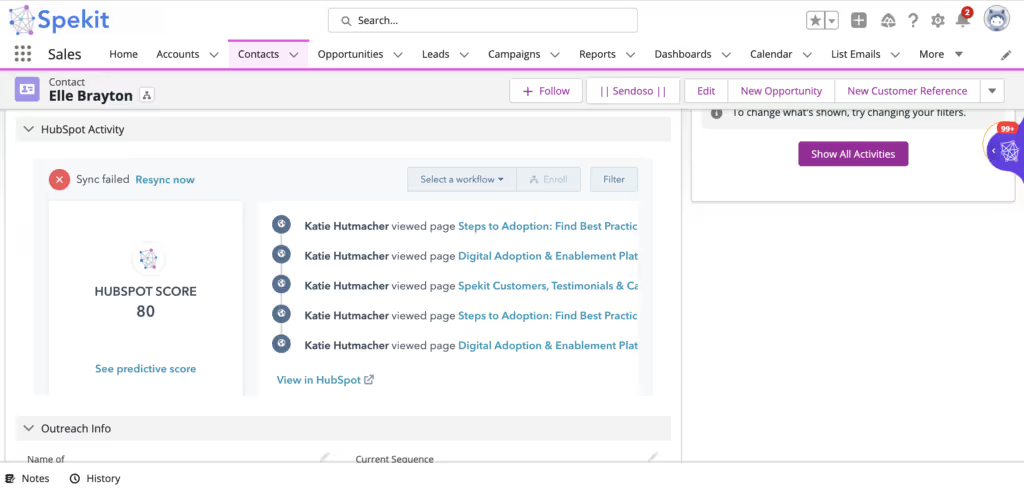
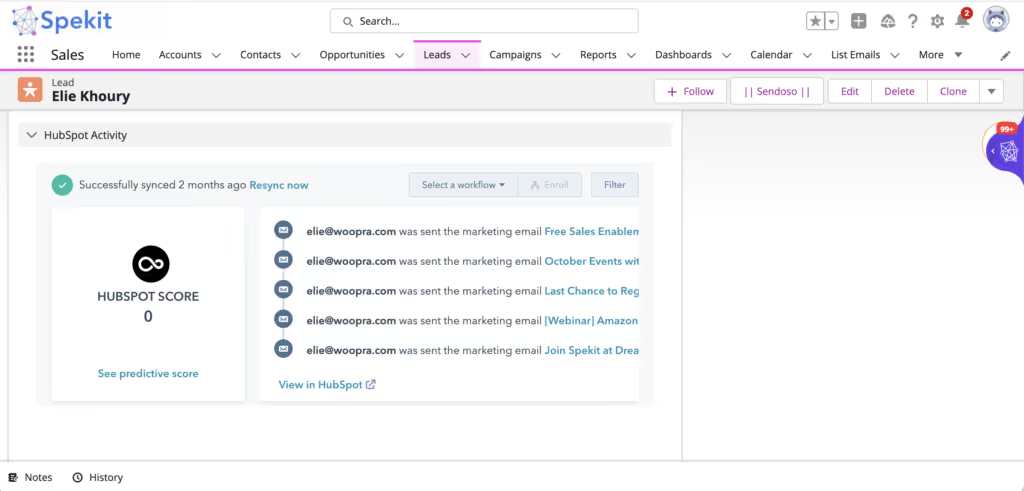
PRO TIP: Make sure the default tab on every record page is the Details tab, not the Related tab because users never look for related tabs first.
7b. Hide components whenever you can
You can dynamically hide components on a page based on several different filters.
For example, let's say a deal is in Stage 1. You probably don’t need the component that allows you to generate a document. By hiding this component, you'll eliminate any confusion for your users.
Leverage the Set Component Visibility functionality to control when certain components are hidden from the screen (based on any user attribute or a specific record).
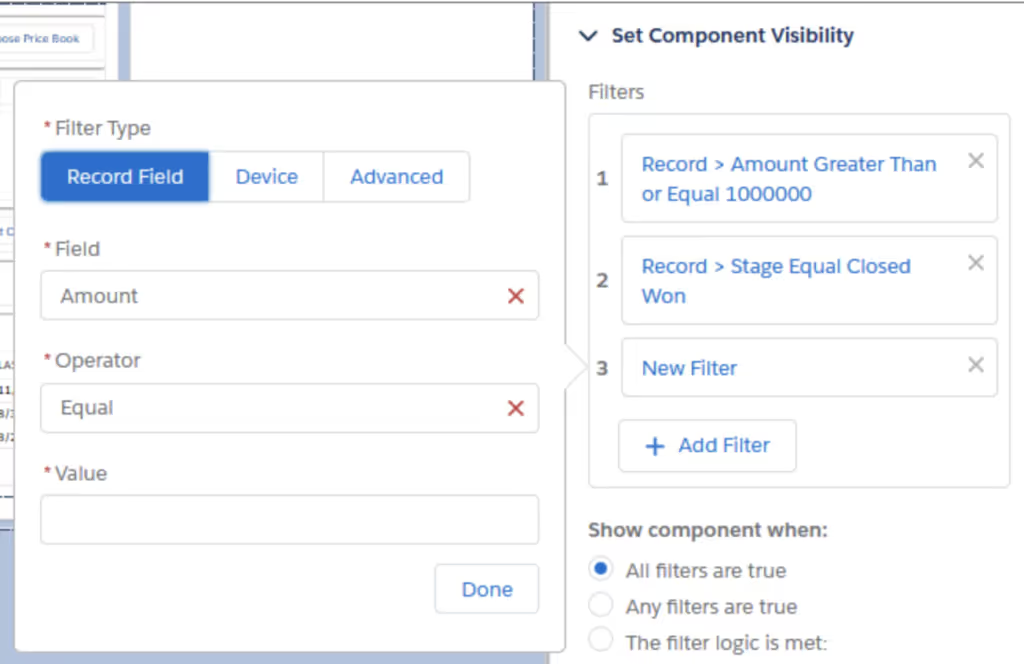
PRO TIP: You can also get super fancy with page layouts and dynamically change the page layout with a trigger based on a field!
7c. Customize and leverage Global Actions
Teach your users how to leverage Global Actions to easily create new records without leaving the screen they're working in.
You can add actions such create a New Lead, create a New Task, Log a Call, or any other action your users frequently use!
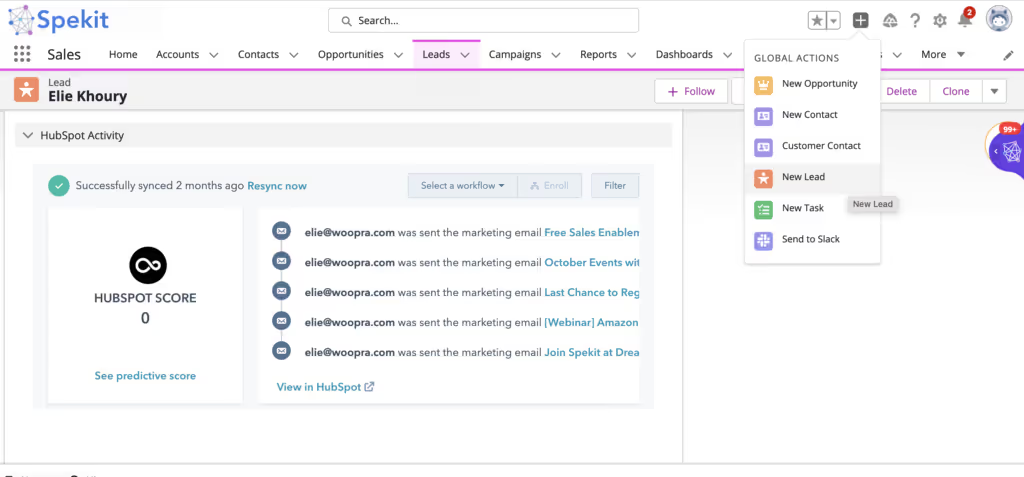
7d. Audit your Salesforce instance for unused fields
Most teams have a ton of legacy fields, some of which have never been used. To analyze and remove unused fields, run a periodic audit to try and keep your Salesforce instance pristine. If any fields don't serve a clear purpose, delete them to keep your org tidy.
PRO TIP: FieldPro is an awesome app that can help with this! It automatically will surface a report displaying any fields that haven’t been used recently and can likely be deleted.
7e. Create personalized "MY" Dashboards
Show users the power of Salesforce by creating “MY” dashboards where users can easily see everything they want to know about their pipeline, new leads, performance, deals that need attention, outstanding tasks, and more in a single place.
PRO TIP: Add these reports to your user’s homepage, so it’s the first thing they see when they log in!
7f. Create custom List Views
Create custom list views to highlight the hottest leads, top metrics, accelerating opportunities, and more! Place list views featuring "My [records]" on the homepage to instantly customize the homepage for each user.
For example, we've featured My Open Opportunities, My Open Leads, My Open Cases, and more below.
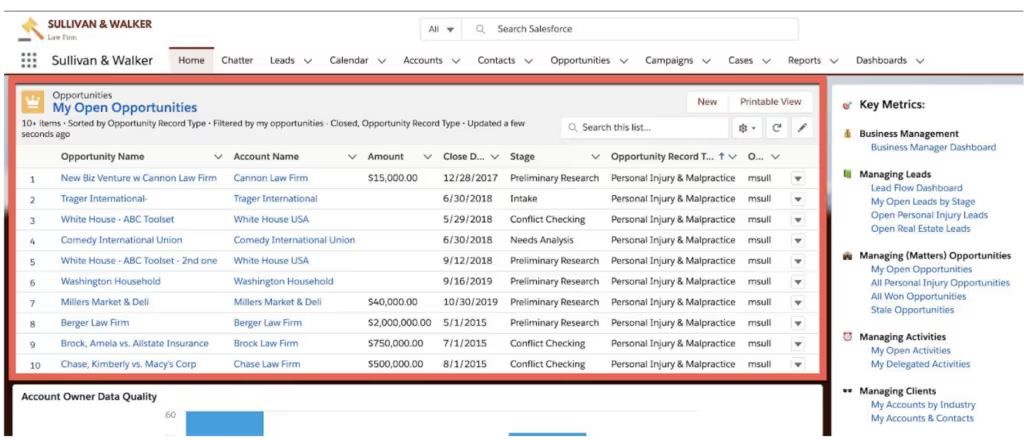
PRO TIP: Teach users how to pin their favorite list views so they’re easily accessible!
8. Conduct a training content audit
At this point, you have a clear understanding of:
- How your users work
- Where they're getting stuck
- Frequently asked questions
- Personalizing Salesforce to each user
Now, it's time to fill the knowledge gaps with training content you can surface to drive adoption of your processes and workflows in Salesforce.
Start by documenting quick answers to your frequently asked questions.
From there, see how you can use Spekit's Salesforce Data Dictionary to automatically import the fields, picklist values, objects, and more from Salesforce for documentation.
Spekit Stories: JLL saves time and boosts efficiency with Spekit’s seamless in-app learning platform
JLL DS has a complex Salesforce org. They not only use not only as their Salesforce CRM, but also for Project Management, Resource Management, Billing and Invoicing of customers. Upper management has long stressed the need for technical documentation on their org in the form of a data dictionary where data field attributes can be documented and defined, including details like who populates the fields, what various values in picklist fields mean, etc.
“Data quality is a big priority for JLL to ensure the impact of this transformation can be measured,” said Marshall King, the Senior Vice President, IT Solutions at JLL.
The problem with keeping this information in Excel is that there’s no true version control, and it’s all but impossible to know who currently holds the most up-to-date copy.
With Spekit’s Salesforce Data Dictionary, JLL was able to begin documentation in minutes, maintain control over that documentation and easily identify any gaps.
“What I loved most about Spekit is that I could start with any record in Salesforce and go through each field one by one, through the lens of an end-user, and create Spekit training content in Spekit right from within Salesforce,” said Ann-Renee Thrash, Training & Documentation Specialist at JLL- > Read more
9. Ensure training is easily digestible
Maintain the right supporting documentation. While institutional knowledge is valuable, it’s also fleeting.
Remember that if new information isn’t applied, users will forget about 75% of the training you covered in just six days.
High-quality process documentation and training content are essential to give your teams a place to go with any questions that come up down the line. Content should be tailored to today’s learner:
- Short, easily digestible images, videos, and text
- Check out Loom, Vidyard, or CloudApp for screen recording tools
- Make it easy to access - don’t hide it in folders that your users won’t access
- Multiple formats and mobile-friendly
- Centralize documentation to avoid users searching multiple sources.
10. Make training accessible when and where questions arise
For most organizations, whenever an employee has a question or needs to find a resource, they're forced to switch to a different tool to find the answer.
In fact, a recent study by Soroco found that employees are toggling, "between different apps and websites 1,200 times each day!” - Soroco
Each toggle represents a drain on productivity, adding up to an average of four hours a week spent simply context-switching.
PRO TIP: Find out how much context-switching costs your organization with our Context-Switching Calculator!
Companies that limit context-switching, putting more information at their employees' fingertips, will quickly see a rise in self-sufficiency, productivity, and impact from their employees.
Instead of employees sifting through Google docs, training videos, or pinging you on Slack, they instantly find the answers they need without leaving their workflow in Salesforce. With a digital adoption platform for Salesforce, training and process guidance automatically appear directly beside the defined terms, objects, and more.
With Spekit, training and process guidance automatically appear directly beside the defined terms, objects, and more in Salesforce.
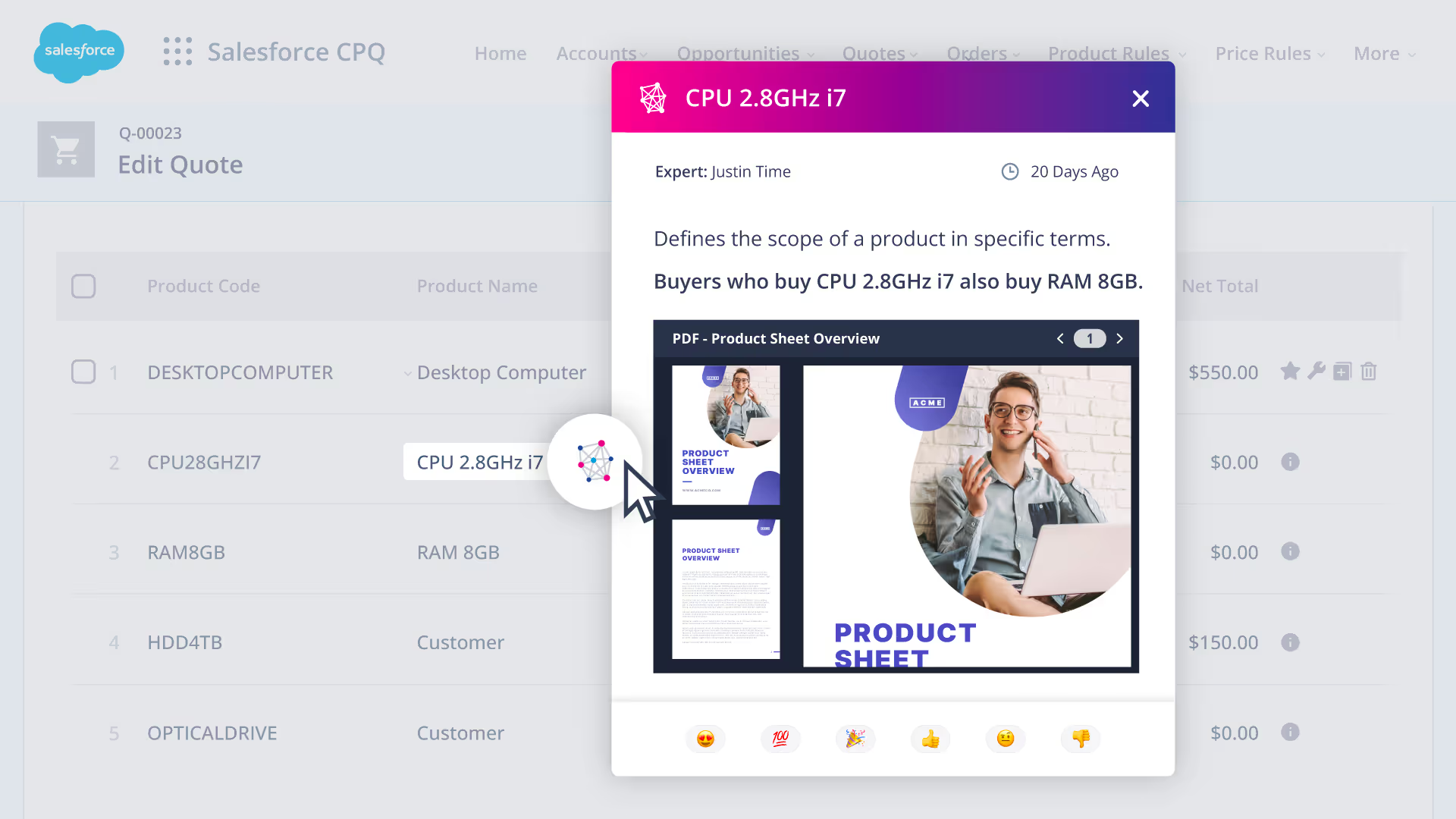
Specifically designed for driving Salesforce adoption, Spekit removes that gap between having questions and getting answers so employees can adopt your tools and processes faster.
Spekit Stories: Building a Pandemic-Proof Onboarding Process with Kara Factor from Southwest Airlines
Our training and onboarding team is lean. It’s just me and my boss. That puts huge demands on our time, especially when a new hire class has recently joined. No matter how good training materials are, people will always have questions and rely on others for answers. In the past, we’ve leaned heavily on human trainers to handle these queries—but not anymore.
We introduced Spekit, a digital enablement tool, as our third teammate. It’s an always-on overlay for our tools, allowing employees to access training content on their own. Frequently, someone will forget how to fill in a particular form or field in Salesforce. Before Spekit, they would have asked me for help, and I may end up answering the same question 10 times a day. Now, they can access a pre-recorded walkthrough within Salesforce. It’s the help they need, when they need it, in their workflow. It’s accessible, scalable and located right where it’s needed.
Although we see huge potential in Spekit, we’ve implemented it with intentional care. Instead of overloading it with all of our training material, we use it to communicate small snippets of information, like the justification behind a new field or how to use a new form. Our goal is to use Spekit to connect the dots between tasks and outcomes, helping employees understand the why behind their work. -> Read More
11. Communicate the heck out of everything
Salesforce adoption is a continuous process. Every time you make a change, an update, implement a new process, etc., you need to get buy-in all over again.
Make it a continuous process.
Create a layered communication strategy leading up to any change. Make sure this is reinforced again and again by leadership. Here are some ways to do this:
- Top-down reinforcement during all-hands with leadership
- In-app alerts with Spekit
- Short, timely, training sessions
- Sales meetings: Spend 5 minutes at the start of each meeting highlighting what’s coming up on the roadmap or encouraging good behavior
- SKOs: Leverage your Sales Kick-Off meeting to get your team excited
- Email drip campaigns: Send reminders in the weeks after roll-out highlighting interesting use cases or features in Salesforce that might benefit them.
- Chatter/ Slack notifications
Spekit Stories: The Change Management Strategy Behind NorthMarq’s Transformation with Dan Ritch
To win over hearts and minds, we communicate at three levels: individual, team, and organization. All three have the same theme , but they’re different types of communication.
To communicate across the three levels, we relied on a battery of channels, campaigns, and strategies.
Our Tech Tuesday update goes out every other Tuesday, come rain or shine. It’s a consistent feed of everything that’s going on. Because we have this unbreakable communication schedule, nothing arrives by surprise. We announce, preview, and launch every new development in separate updates.
We also spun up roadshows. We went from team to team, training employees on what we needed them to do. It was face-to-face and personable. Although Tech Tuesdays had me in a presenting role, our roadshows really were all about the team. We were speaking live to small groups or individuals. We were answering questions and providing detailed instructions. Although the pandemic forced us to pivot to virtual roadshows, We are in the midst of planning a six-week roadshow and look forward to being face-to-face (safely).
Finally, we integrated a digital enablement tool, Spekit, as a sort of digital companion. We think of it as our swivel chair replacement. That’s a reference to someone getting stuck on something in the office and swiveling their chair to ask a colleague for help. But instead of physically swiveling, they can use Spekit to instantly get help, wherever they are.
Let’s say I need to know how to enter a customer contact into Salesforce. I just go into Salesforce, and Spekit visually walks me through the process. Considering how much we’re changing, having always-on reinforcement, directly within our employee’s workflow, is invaluable. -> Read More
12. Incorporate spiffs or contests to make it fun!
The word "training" generally garners the same reactions. Ugh! Dull! Who has time for this?
At this point, you've sold them on the "why" so they understand the value. But what's the icing on the cake to get them excited?
Reinforcement should be targeted around the behavior and outcomes you seek, and it isn’t too early
to start encouraging the right habits. For example, consider tagging on a spiff when providing access to your end users as a reward. Ask yourself these questions:
- What is the behavior you are trying to encourage?
- What would be the threshold for what good looks like?
- How would you translate this into measurable output?
- What would be the criteria for a fair spiff that assumes a level playing field?
- How would you create a different spiff for each role using the technology, depending on their
- responsibilities and team KPIs?
- What would be a meaningful spiff or reward? Maybe your teams love gift cards, dinner, gadgets, and swag, or who doesn't like cold hard cash?







